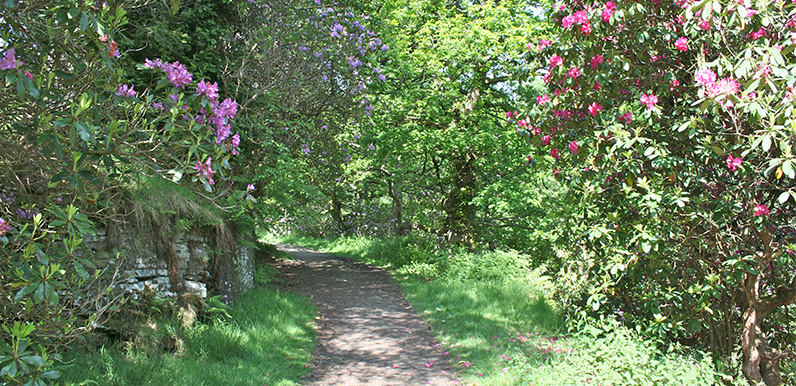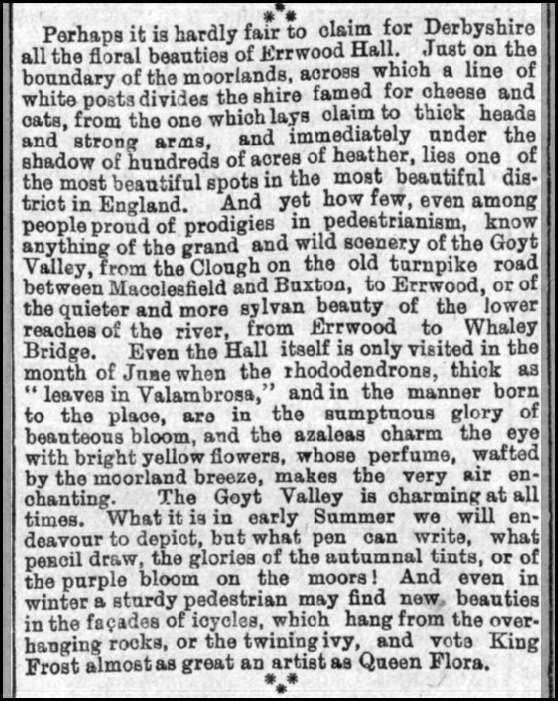Above: The rhododendrons in full bloom are a magnificent sight. I took this photo in June a few years ago, along the approach to Errwood Hall (see walk 7).
Above: This clipping from an 1883 edition of the Derbyshire Times (click to enlarge) waxes lyrical about the beauty of the rhododendrons in the Goyt Valley: “…the rhododendrons are in the sumptuous glory of beauteous bloom.”
It seems the Forestry Commission is cutting down quite a number of rhododendrons in the valley. I know they’ve been reducing them around Errwood Hall. I assumed they were just being rigorously pruned. But it seems it’s a bit more serious than that.
There’s a post on the Forestry Commission’s website responding to a visitor’s complaint about the number being removed. (Click here to view.) They say;
We consider rhododendron to be invasive and are reducing them in the Goyt Valley accordingly although we will leave some specimens near Errwood Hall. Additionally, they can also be a host for Phytophthora which affects other trees such as larch and sweet chestnut. An outbreak of this disease is the primary reason for the most recent removal of rhododendron.
I think the Commission is doing a great job in removing so many of the fir trees to allow the native trees to repopulate the landscape. But the rhododendrons in full bloom are a wonderful sight.
I can understand if they are diseased and a danger to other trees. But the comment about them being ‘invasive’ does concern me. Surely they can be pruned to ensure they leave space for other trees and vegetation. It would be a great pity if they vanished from the landscape.
It’s said that the rhododendrons were introduced into the valley by Samuel Grimshawe. And were brought back from his travels as ballast in the family’s ocean-going yacht, the Mariquita. My favourite Victorian guide to the Goyt Valley, Strephon, has this to say about them;
“Errwood when the rhododendrons are in full bloom is a place difficult to imagine and impossible to describe. They rise from rocks in ramparts of rose colour and Pyrian purple, tier above tier, tint upon tint, until, with the blue black firs and pines, they break the diversified sky-line.”
Page update: 2018
It’s now over a year since the rhododendrons were removed from around the ruins of Errwood Hall, and heavily pruned on the surrounding slopes. This fade shows the scene before and after.
I’ve been delighted with the way the Forestry Commission have been felling the fir trees around the valley. But I have to say I think they’ve been very cavalier in the way they’ve cut down the rhododendron bushes.



I visited the Goyt Valley for the first time last week. Great place, but what a shame about the rhodies. We went with friends who live locally and what a mess the Forestry Commission have made. Surely pruning would be a better option, but if they are diseased, what about the other plants in the valley? Still a lovely walk.
On visiting yesterday for the first time in 20+ years, I can’t over-state how disappointed I was at the destruction of the beautiful rhododendron bushes – my main reason for visiting. I read that the F.C. regarded as ‘invasive’? To what? Even the RHS describe them as “beautiful” and only “in need of sensitive pruning”. It was mainly because of them that it was such a singularly beautiful place. Now it looks like somewhere which has been bulldozed, hacked and ruined – even the branches and trunks have just been left in the stream! Really – who do you the F.C. think they are? They are vandals, who have completely destroyed the scene.
I have recently been ill and unable to visit such beautiful places as the Goyt Valley and so was unaware of the destruction by the Forestry Commission of the beautiful rhododendrons. I am appalled. I agree with other comments; would not ‘selective pruning’ been a better option, thus leaving the legacy of the bushes provided by Mr. Grimshawe all those years ago, for many generations to come to enjoy in all their glory?
I am appalled that the stated aim of the FC is to destroy ALL rhododendrons in Scotland. Who gave them this power?
Rhododendrons aren’t native to the UK. They are invasive unless controlled and not a native plant. I also understand the nectar is toxic to the honeybee, see report from Kew Gardens. Keep up with their removal F.C.